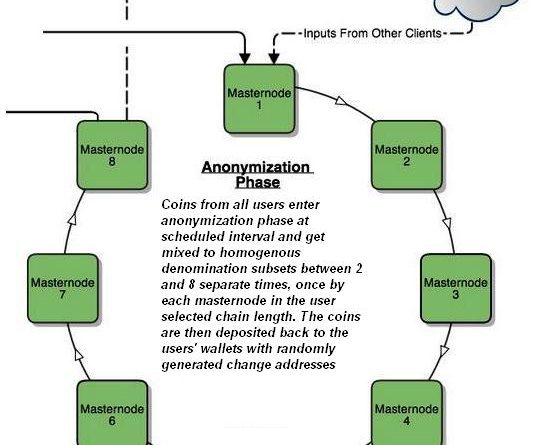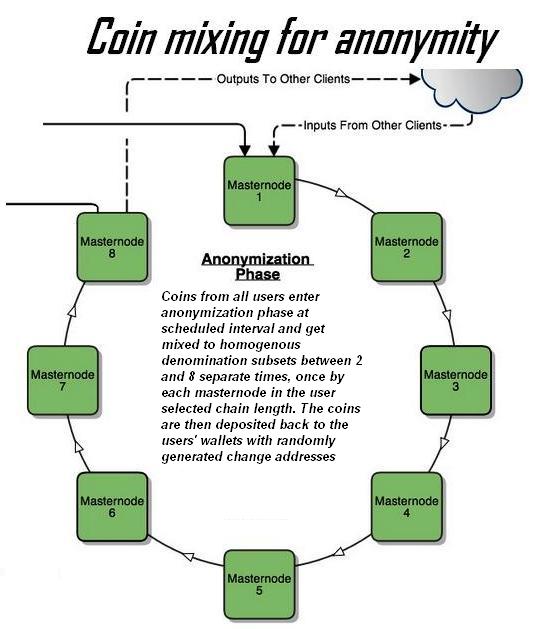What is a Masternode?
A masternode is a special trustless and decentralized server that carries out a number of functions on the blockchain network such as instant send, and coin mixing to add privacy of transactions in the network.
They also help achieve a true level of decentralization, meaning they facilitate decentralized management and administration of the distributed network such that the network will not favor any country, geography, company or person because those running masternodes have additional responsibilities such as voting on development matters and issues. They ensure a decentralized budgeting system and an immutable proposal and voting system.
Masternodes also play the important role of stabilizing the network since those running them must retain some amount of currency or coins in the network to run the nodes.
In technical terms, masternodes are network nodes that run the same wallet software on the same blockchain in order to provide the above said and additional services.
Masternodes play a very important role and are, indeed, a backbone of the network. They are a resource or services that can be provided by anyone on the blockchain network as far as the person has the required financial and hardware capability. The individual providing these services get rewards and dividends in the form of the coin in question, on a periodic basis defined by the cryptocurrency company.
History of masternodes
Dash coin -- formerly known as Darkcoin -- is the pioneer of the masternodes system and has, so far, the largest pool of node operators, with 4,100 masternodes since launching in 2014.

In 2014, Evan Duffield, who invented Dash coin, wanted to have a cryptocurrency that could achieve more privacy of transactions than did Bitcoin at the time. He came up with the idea of adding a second-tier of features or functions on top of the mining network features. The system so desired would reward full nodes that he thought were also important to the network in addition to the miners.
Duffield targeted that these nodes would provide the network with additional tasks and be properly incentivized for it. The people running masternodes would retain some amount as collateral to ensure benevolent behavior.
Therefore, masternodes were first introduced as an engineering effort to support coin mixing in Darkcoin's DarkSend (now PrivateSend) and were originally described below by Evan Duffield in April 2014.
“These nodes are the foundation of DarkSend, all transactions will be routed through these nodes. Each masternode requires that 1000DRK be kept on the node and each time that node is selected the network will dedicate 10% of that block to these nodes. If you are running a masternode you need to be fairly familiar with network administration and securing your host.”
The percentage of reward going to Dash masternodes has since changed. Today, there are tens of cryprocurrencies running masternodes and you can check for further details, including which coins and database on this link.
Why masternodes are important in a crypto network?
Privacy and anonymity are the keywords for crypto users, but there are more benefits accruing to both users and the cryptocurrency company.
Dash, for instance, uses masternodes to anonymize transactions such that anyone can use this feature directly on their wallet to send anonymous transactions. Masternodes achieve anonymity by ensuring that there is no centralized party to attack or take down the network or transaction by way of coordinate mixing of the coins.
Dash's system achieves some good level of privacy, although it is said that the one downside of the structure was the introduction of Anti-Money Laundering and Know Your Customer support into the Dash blockchain because transactions and identities are linked so thoroughly.
The higher the number of masternodes on the network the more the security of any cryptocurrency network and the capacity for end-users to access digital cash from anywhere in the world at any time of the day, thanks to the decentralization factor.
Therefore, masternodes also improve efficiency of the network by ensuring that all transactions are validated in near real-time. In Dash, masternodes run a Dash wallet and can lock transactions with InstantSend.
In addition to helping cryptos achieve decentralization of the network (all cryptocurrency networks do not have a central way of managing and administering the network or making important financial decisions), improving security of services, stabilizing the network and enabling carrying out of various functions such as instant send, various cryprocurrencies such as Dash also used masternodes to allow more people to contribute to the network because not everyone can contribute to the network as a miner. Dash was, at that time, priced much lower per coin and used masternodes to attract investors to facilitate appreciation of the coin value over time.
Masternodes also vote on budget funding once proposals get forwarded by members of the community in order to determine which proposals should be funded. They thus have some control on development matters.
For users intending to run a masternode, one would desire earning the interest -- running masternodes can earn a lot of passive income since rewards keep flowing on a daily basis. In addition to the normal reward, you also earn fees when members of the network use your services on the blockchain.
Individual masternodes on Dash networks can be selected or nominated as recipient of part of each mined block's value.
In all the cryptocurrencies, the number of masternodes keep increasing, meaning the share of block value each masternode receives, keep decreasing. For instance, it is expected that the number of masternodes on the Dash network -- which is 1000 and earning 45 percent of the block reward as per the start of 2016 -- will increase in number such that the ROI will reach 4.5 percent annually by 2029.
How masternodes work
First, a user who wishes to run a masternode requires investing a certain amount of coins in the network and then do some technical set up. For instance, one requires keeping 1000 Dash coins in the Dash wallet to be able to set up and run a masternode. Moving the coins out of the wallet, which is possible at any time, removes the masternode from the network and the wallet address is no longer illegible for rewards as expected.
Since it is possible that large investors can hold a large number of masternodes such that they control the network much like having a majority shareholder in a company, there has to be methods to prevent this from happening in order to continue with the cryptocurrency goal of decentralizing the system. Although there are additional benefits of having a high number of masternodes to a network, increase in the number of masternodes can also compromise or lower the security of a PoS network since increase in the number of masternodes would lower the number of users conducting the Proof of Stake (PoS) mining activities.
It is also possible for a cryptocurrency network to unfairly reward masternodes a larger share of the blockchain rewards more than other users than should be. This is avoided through a balancing mechanism that promotes an even ratio between staking nodes and masternodes in the network.
There are many ways in which various cryptocurrencies balance the ratio. PIVX PoS block system uses a variable Seesaw Reward Balance System that adjusts the reward ratio dynamically. In PIVX, every reward is split by 10:90 with the first portion going to budgeting and the second to both masternodes and stake mining.
The PIVX reward balancing system then further splits the 90 percent to award fairly the masternodes and stakers such that the higher the masternode count, the smaller the reward portion going to the masternodes and the larger the portion going to the stakers, and vice versa. If the amount of coins locked to masternodes is lower than 1% of the total coin supply, the reward system starts with a ratio of 9 to 1 towards masternodes. When the number of coins surpasses 41.5 percent of the total supply, the balancing mechanism shifts such that more than 50% of the block reward goes to staking nodes.
With such a system, approximately 60 percent of the total coin supply is made available for staking to secure the network and maintain liquidity while keeping a strong network of masternodes. The system also ensures that running masternodes at any time is profitable more than staking an equal amount of coins below the equilibrium threshold. This is because maintaining masternodes comes with extra cost, risk and time.
Such a system encourages incentivizing of the masternode owners such that the owners are more likely to give up their votes and stake coins instead of wanting to own more masternodes, unlike in Dash where those with more masternodes are simply encouraged to get more, which increases the cost of running a masternode. DASH does not have a variable masternode or stake reward balancing system. Instead, masternodes get 45 percent of the block reward on each block and this is distributed to the masternodes one at a time, leading to a pace of about 2 dash being paid to each masternode every 7 days at the current rate.
In Dash, 45% of the block reward goes to the miner, 45% goes to masternodes, and 10% is reserved for the budget system (created by superblocks every month). Dash uses the Proof of Service (PoSe) for its masternodes where a masternode network can orphan any block on which a miner tries to take the entire reward from that block for him or herself such that the block will not be added to the blockchain. Masternodes also orphan the block is the miner is using an old version of the Dash software.
This is because the miners power the first tier of the network (sending and receiving the transactions and avoiding double-spending) while masternodes add the second tier, which is to govern the network and make decisions. They can, for instance, reject improperly formed blocks from miners. Masternodes do not mine.
How much do you earn by running masternodes?
The return on investment varies from one coin to another. For instance, Dash masternodes earned 11% return on 1000 Dash for the year of 2016 and although the percentage has been reducing over the years, the value of the coin keeps appreciating and the supply going down, therefore, those running masternodes should still feel sufficiently rewarded. Remember there is an additional fees earned by masternodes when someone uses their services (InstantSend and PrivateSend) on the network.
That means the amount you earn while running masternodes depends on the value of the coin, which changes over time, and the number using your services on the network. Remember, different cryptocurrencies also have different payout periods, some daily, others a few times in a day, and still others a few days in a week.
For those asking how much they can earn with the PIVX masternodes, you can estimate earnings from masternodes using Cryptonode tool or check the company graphs explaining how much of PIVX rewards you should expect.
The reward from last block going to masternodes was 2.25 PIV as of this writing and the estimated payment per masternode was 1.48 PIV/day or about $158.94/month or $ 1933.82/year. As you can see, the masternodes might be worth the hassle although you need to first put 10,000 PIVX into a locked account when starting which means you need to allow for a couple of days of earning to recover the cost and you continue earning. Of course, you can withdraw the 10,000 PIVX from the wallet at any time but you would stop earning the rewards.
Masternodes on ChainCoin are paid 25% of the block’s reward.
For details on how much you can earn on masternodes with various cryptocurrencies, check official websites of each cryptocurrency.
Setting up masternodes
Different cryptocurrencies have different requirements for setting up and starting with masternodes. For instance, Dash requires users to have a server or a VPS (Vultr and DigitalOcean and other cheaper servers are acceptable) installed with Linux and with a dedicated IP address (comes with a VPS or server), be able to run the server for 24 hours with not more than 1 hour of connection loss. You can read on how to set up masternodes on the Dash network.





